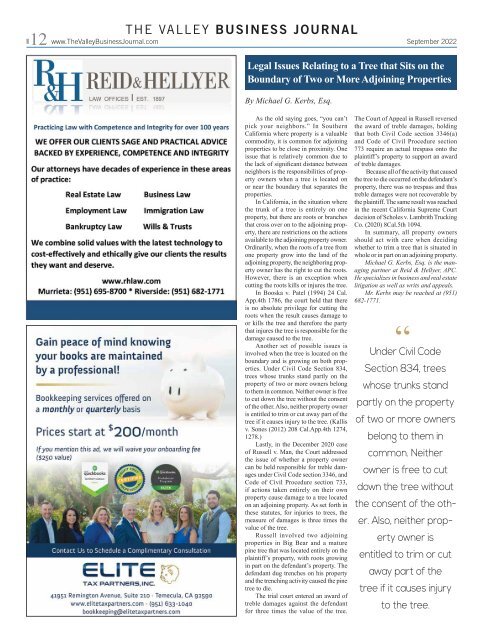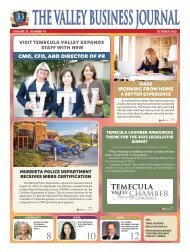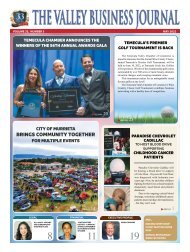VBJ September 22
Create successful ePaper yourself
Turn your PDF publications into a flip-book with our unique Google optimized e-Paper software.
THE VALLEY BUSINESS JOURNAL<br />
12 www.TheValleyBusinessJournal.com<br />
<strong>September</strong> 20<strong>22</strong><br />
Legal Issues Relating to a Tree that Sits on the<br />
Boundary of Two or More Adjoining Properties<br />
By Michael G. Kerbs, Esq.<br />
As the old saying goes, “you can’t<br />
pick your neighbors.” In Southern<br />
California where property is a valuable<br />
commodity, it is common for adjoining<br />
properties to be close in proximity. One<br />
issue that is relatively common due to<br />
the lack of significant distance between<br />
neighbors is the responsibilities of property<br />
owners when a tree is located on<br />
or near the boundary that separates the<br />
properties.<br />
In California, in the situation where<br />
the trunk of a tree is entirely on one<br />
property, but there are roots or branches<br />
that cross over on to the adjoining property,<br />
there are restrictions on the actions<br />
available to the adjoining property owner.<br />
Ordinarily, when the roots of a tree from<br />
one property grow into the land of the<br />
adjoining property, the neighboring property<br />
owner has the right to cut the roots.<br />
However, there is an exception when<br />
cutting the roots kills or injures the tree.<br />
In Booska v. Patel (1994) 24 Cal.<br />
App.4th 1786, the court held that there<br />
is no absolute privilege for cutting the<br />
roots when the result causes damage to<br />
or kills the tree and therefore the party<br />
that injures the tree is responsible for the<br />
damage caused to the tree.<br />
Another set of possible issues is<br />
involved when the tree is located on the<br />
boundary and is growing on both properties.<br />
Under Civil Code Section 834,<br />
trees whose trunks stand partly on the<br />
property of two or more owners belong<br />
to them in common. Neither owner is free<br />
to cut down the tree without the consent<br />
of the other. Also, neither property owner<br />
is entitled to trim or cut away part of the<br />
tree if it causes injury to the tree. (Kallis<br />
v. Sones (2012) 208 Cal.App.4th 1274,<br />
1278.)<br />
Lastly, in the December 2020 case<br />
of Russell v. Man, the Court addressed<br />
the issue of whether a property owner<br />
can be held responsible for treble damages<br />
under Civil Code section 3346, and<br />
Code of Civil Procedure section 733,<br />
if actions taken entirely on their own<br />
property cause damage to a tree located<br />
on an adjoining property. As set forth in<br />
these statutes, for injuries to trees, the<br />
measure of damages is three times the<br />
value of the tree.<br />
Russell involved two adjoining<br />
properties in Big Bear and a mature<br />
pine tree that was located entirely on the<br />
plaintiff’s property, with roots growing<br />
in part on the defendant’s property. The<br />
defendant dug trenches on his property<br />
and the trenching activity caused the pine<br />
tree to die.<br />
The trial court entered an award of<br />
treble damages against the defendant<br />
for three times the value of the tree.<br />
The Court of Appeal in Russell reversed<br />
the award of treble damages, holding<br />
that both Civil Code section 3346(a)<br />
and Code of Civil Procedure section<br />
773 require an actual trespass onto the<br />
plaintiff’s property to support an award<br />
of treble damages.<br />
Because all of the activity that caused<br />
the tree to die occurred on the defendant’s<br />
property, there was no trespass and thus<br />
treble damages were not recoverable by<br />
the plaintiff. The same result was reached<br />
in the recent California Supreme Court<br />
decision of Scholes v. Lambrith Trucking<br />
Co. (2020) 8Cal.5th 1094.<br />
In summary, all property owners<br />
should act with care when deciding<br />
whether to trim a tree that is situated in<br />
whole or in part on an adjoining property.<br />
Michael G. Kerbs, Esq. is the managing<br />
partner at Reid & Hellyer, APC.<br />
He specializes in business and real estate<br />
litigation as well as writs and appeals.<br />
Mr. Kerbs may be reached at (951)<br />
682-1771.<br />
“<br />
Under Civil Code<br />
Section 834, trees<br />
whose trunks stand<br />
partly on the property<br />
of two or more owners<br />
belong to them in<br />
common. Neither<br />
owner is free to cut<br />
down the tree without<br />
the consent of the other.<br />
Also, neither property<br />
owner is<br />
entitled to trim or cut<br />
away part of the<br />
tree if it causes injury<br />
to the tree.
















